importance and shares some examples of practice

It is more than 50 years since Rachel Carson's massively influential book Silent Spring was published in 1962. This was a text that more than any other stimulated the initial development of a modern environmental movement.
In Silent Spring, Carson wrote about the child's world as being full of wonder and excitement, and said she felt sad that these 'true instincts' of childhood for natural beauty were so often lost before adulthood.
Education for Sustainable Development (ESD) is now high on the international agenda and ESD is seen as a way to encourage greater sustainable consumption and production, to counter the effects of climate change, address threats to biodiversity and provide more effective disaster risk reduction. As the Swahili proverb reminds us: 'You must treat the earth well. It was not given to you by your parents. It is loaned to you by your children.' (Itunze arthi vyema; hukupewana wazazi; bali umekopeshwa na wazao wako.)
Following the launch of the United Nations (UN) Decade of Education for Sustainable Development (2005-2014), the UN Economic Commission for Europe drew up a separate Strategy for Education for Sustainable Development in 2005, and recognised that: 'Education for Sustainable Development is a lifelong process from early childhood to higher and adult education and goes beyond formal education. As values, lifestyles and attitudes are established from an early age, the role of education is of particular importance for children.'
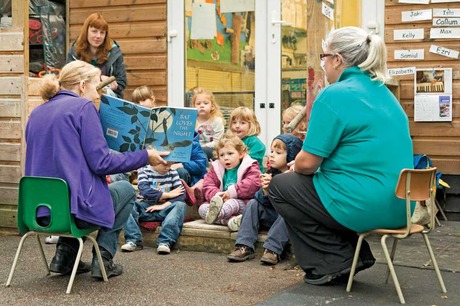
ESD has often been associated with curriculum projects linked with recycling; animal, energy and water conservation; pollution reduction and sustainable consumption - all developed to contribute towards achieving a more sustainable future.
Research from developmental psychology, longitudinal studies, social cultural analysis, and neuroscience have all shown that it is in the early years that children have the greatest capacity to learn, and it is in these years that many of our fundamental attitudes and values are first put into place. Much of this work is, therefore, already happening in the best of our pre-schools.
Children are already investigating issues related to recycling, energy conservation, waste disposal and changes in their local environment. In the best practice, children share their thoughts and findings with parents and the local community, and record them by drawing, writing, creating charts and using digital imaging. Many pre-schools are also joining primary and secondary schools in whole-school certification programmes such as Eco-Schools.
But ESD in Early Childhood Care and Education (ECCE) is of even more significance than this. The development of ESD in ECCE requires more than just curriculum development. ESD in ECCE provides the possibility of a transformational reconstruction of ECCE, rather than just a new initiative within it.
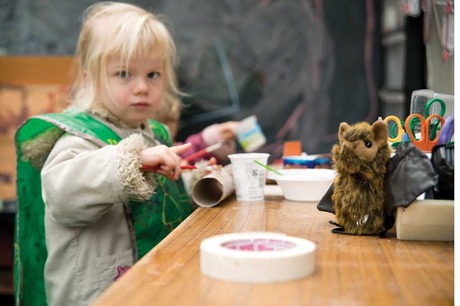
UNICEF reports show that children under the age of eight represent the highest percentage of affected populations in today's global emergencies. A UNESCO (2013) survey conducted in a review of the 2005-14 UN Decade of Education for Sustainable Development has shown that the ministries of education, environment and sustainable development in 97 UN member states identify poverty as the highest priority area to be addressed in achieving sustainable development. In fact, reductions in poverty and inequality are widely recognised as the priority in efforts to create a more sustainable world.
Research has convinced governments from around the world that effective early childhood care and education can give children a better chance of escaping poverty and breaking out of the vicious cycle of disadvantage. At a global level, millions of children start school carrying the handicap that comes with the experience of malnutrition, ill-health and poverty. Yet, inequitable access to high-quality pre-school programmes remains a problem in both rich and poor countries.
The UN Sustainable Development Goals (SDGs) are currently being formulated to replace the UN Millennium Development Goals (MDGs) that defined the global development efforts and targets and which expire in 2015. Sustainable development projects that enable rapid progress in maternal health, child nutrition and survival already exist, even in some of the world's poorest countries. Linking health and education agendas has been recognised as crucial.
Other policies include scaling up maternal and child health services, aid-based health initiatives, free health care, putting nutrition at the centre of the poverty reduction agenda and large-scale social protection programmes that include child nutrition.
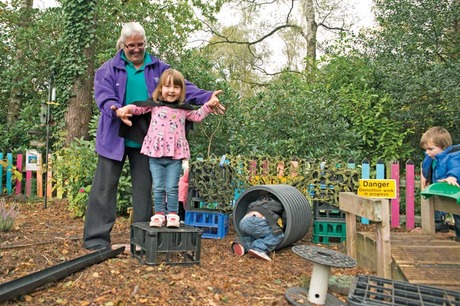
EARLY YEARS PRACTICE IN THE UK
In the early years, many of the best ESD projects tend to involve the children working playfully side by side in common activities that are interspersed with whole-class discussions, short presentations by visitors and associated storytelling and songs. These activities are strongly structured and scaffolded by the adults.
In the pre-primary year, projects often involve investigation or problem-solving activities and project work. These activities often have a strong emphasis on encouraging the children to develop their communication, co-operation and collaboration skills at the same time as they learn about the concerns of ESD.
Projects come in all shapes and sizes, but a good example of this kind of activity may be taken from a project conducted at Alderholt Sunbeams Pre-School and Day Nursery, Dorset.
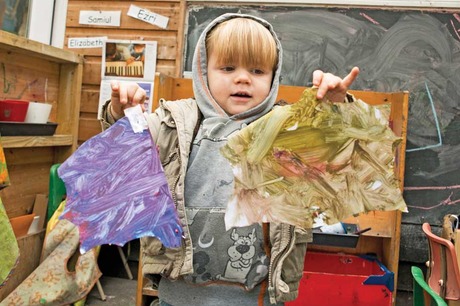
BAT CONSERVATION AT ALDERHOLT SUNBEAMS IN DORSET
This three-week project was developed with the support of a local woodland educator and forest school instructor Zoe Miles, who was able to draw on her expert knowledge of the local bat population and their habitats. The children's storytime featured Bat Loves the Night by Nicola Davies and Sarah Fox-Davies and the children discussed: why bats hang upside down, what UK bats eat, how bats stay up, whether bats are birds or animals, and why bats matter.
The children were taught a Bat and Moth Game that introduced them to the idea that bats use their hearing to find their prey. They were given bat costumes and taught bat songs and games. A video on 'echolocation', the bat location device, was also shown.
The children made model toy bats with flapping wings that hung upside down around the classroom for counting and following a session with Zoe looking at 'where bats live', they started making their own model bat habitats using recycled materials.
Zoe provided an evening of bat observations with parents using heterodyne detectors, which make the bat calls audible to the human ear. Both a pipistrelle and a noctule bat were identified.
The children learned songs about bats and the project ended with a presentation to Zoe of what the children had achieved, including the final bat 'houses' that they had made. She also brought along a 'bat box', which she fitted to a tree in the pre-school grounds and provided a roost to support conservation.
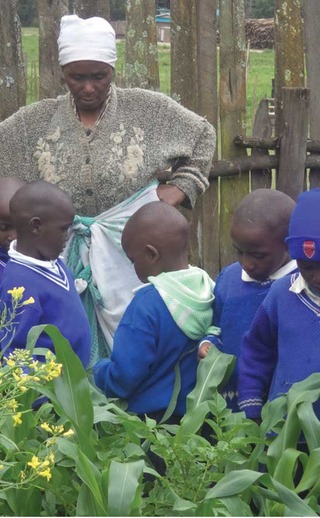
OVERSEAS PARTNERS
The Sunbeams bat project provides an illustration of a typical ESD activity suitable for three- and four-year-olds. Many pre-schools around the country are benefiting from collaborations with forest schools and forest school outreach support. Zoe Miles also contributed to another project that shows how a partnership with an overseas partner pre-school can provide educational benefits that work both ways and provide a valuable global perspective.
This project involved Cranborne Pre-School in Dorset, UK, and Ng'ondu, a very poor pre-school in Njoro, in the Great Rift valley of Kenya. The UK-Kenya Pre-School Partnerships were developed as a World Organisation for Pre-School Education (OMEP) ESD pilot project in 2012 to encourage partnerships between OMEP pre-schools in the global north and the global south.
The project involves activities being developed collaboratively, carried out at each of the pre-schools and then reported to the children and parents online through the internet. These reports provide rich curriculum materials for use in the classrooms in the UK and in Kenya.
THE CRANBORNE-NG'ONDU PARTNERSHIP PROJECT
This project focused on sustainable forestry, and also on gender equality in the UK and Kenya. The children in the both places learned about Wangari Maathai, a particularly brilliant and successful Kenyan environmental scientist who mobilised and encouraged many poor women to plant 30 million trees. Her contribution to sustainable development, and democracy, was recognised in 2004 when she was awarded the Nobel Peace Prize.
Maathai provided a positive role model for the girls, and also served to challenge gender stereotypes held by many boys. In addition to the ESD and social justice objectives of the project, the opportunity was taken to introduce the Kenyan pre-school to socio-dramatic play, used in most UK pre-schools.
This form of play was routine at Cranborne and its classroom already included a 'hospital corner', where the children shared their experiences and learned through their play about the caring roles of hospital staff and the use of science in medicine. Girls underachieve at every level in Kenya and they make up only 38 per cent of university enrolments, so it was considered to be important to counter the common stereotype that men were better in maths and science.
In the process, the children at Cranborne learned about the importance of the world's forests, the threats to their existence and the heroic work of people like Maathai in protecting them. The children were given practical activities identifying all the things around them made from materials such as wood, card and paper.
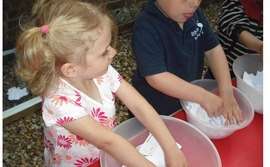
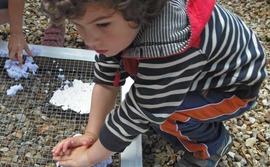
The children were taught about the importance of trees, how long they take to grow, and how quickly they can be destroyed. They made wood 'cookies', and 'woodland crowns', and were able to touch and feel different wood rounds (logs) and bark from conifer, oak, birch, hornbeam and ash.
The aim was for the children to understand the different properties of wood, using their senses of touch, sight and smell. The children were encouraged to draw and personalise their wood cookies with crayons and to use woodland materials (leaves, moss, lichen, seeds, conifers, branches, bark, buds and cuttings from different trees) to create their crowns.
Cranborne donated dressing-up clothes to support the girls in its partner pre-school to develop positive dispositions towards science, and alternative adult roles for women.
At Ng'ondu, the children were shown photographs of the UK children playing in the clothes and three of the girls immediately dressed up and played out the same socio-drama for themselves. The teacher at Ng'ondu later took the clothes to a local college and OMEP Kenya has already paid the students there to produce ten more sets of dressing-up clothes to share with local pre-schools.
Using a tablet PC supplied for the project by OMEP UK, the Kenyan children were shown a video of Maathai. They were told Maathai was the first woman to win a Nobel Peace Prize in Africa, and that her good deeds would live on to inspire many people.
Later, the children were themselves involved in tree-planting activities, and many of the other activities that the children in Cranborne enjoyed were repeated in Ng'ondu.
THE LYTCHETT MATRAVERS-EVERBEST PRE-SCHOOLS PROJECT
Another sophisticated UK-Kenya pre-school ESD project involved the children at Everbest Pre-School in Kenya and Lytchett Matravers Pre-School in Poole, Dorset. The project was focused on 'intergenerational dialogues' and some of the children's grandparents were first invited into the setting to talk about how they used to grow more of their own food in the past.
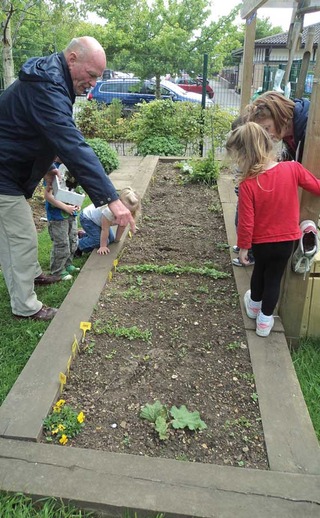
Corn (maize) was planted by the children in both pre-schools. Oliver's grandad, Alf, showed the children at Lytchett Matravers how they could pull the corn off the cobs and plant them to grow more sweetcorn. He had brought some compost and pots from his allotment for them to use to plant the seeds. He then asked the children if they knew what else the seeds would need to grow and at once one of the children, Ruby, said that they needed sunshine and water.
He told them that when he was little there were no big supermarkets from which to buy food. Instead, he grew lots of vegetables, including carrots, potatoes, runner beans and cabbage, and also kept chickens. He said he still grows and likes to eat vegetables from his allotment because they keep him healthy.
Ethan's 'Popsi' also visited the pre-school. He explained that he too didn't go to big shops to buy food when he was young but instead shopped at the local greengrocer in the village and grew peas and carrots in his garden.
At Everbest in Kenya, grandmother Wanjiku visited the pre-school to tell the children about how she had been growing some of her own food since she was their age. She told the children about the old iron jembes (hoes) that were used before they had the mass-produced steel ones, and then she showed them how to dig.
She taught the children how plants need water, light and soil if they are to thrive, and she showed them how they could grow maize at home. Mary asked if the tool could hurt them and Wanjiku said that it could if they didn't handle it very carefully. She showed them a big scar where she had been cut when she was a young girl so the children were very careful with the tools.
The children were then shown how they could remove seeds from the cobs and how to plant them. The children asked if they could eat the seeds and were told that they couldn't because they were not cooked. Then the children asked if they could take some seeds home to grow and they were told that they could. Wanjiku showed the children how to identify and remove the weeds that would grow around their maize.
The children in both pre-schools learned that many families in Kenya continue to supplement their incomes by growing food in their 'shamba' (garden or local plot). The most common crops grown are maize, beans and kale. It is often the women who grow the food; men have traditionally cleared the land, looked after the livestock and milked the animals.
NATIONAL CONTEXTS
In a recent review of ESD in ECCE commissioned by UNESCO (2014), world president of OMEP Ingrid Pramling-Samuelsson and I argue that from a global perspective it is important to recognise that responses and priorities related to 'survival' and 'sustainability' look different in different national and regional contexts.
In many relatively wealthy national contexts, the priority may be to encourage greater respect for finite resources and promote an understanding of global interdependence. In many poorer world contexts, the highest priorities are sometimes to provide the most basic care for children and to improve literacy.
While in the relatively wealthy nations, 'survival' is often seen as a mediumor even as a long-term, abstract, threat, for too many in the 'majority world' the brutal realities of the struggle for survival are all too apparent on a daily basis. What all of the varied 'sustainable' projects that we engage in have in common is the concern to educate children for a sustainable future. The practices themselves may seem very different, but this is only apparent if we ignore our global interdependence. What is emerging within ECCE is, therefore, a series of initiatives targeted at different aspects of ESD:
- Support for children who are failing to achieve their potential right now, due to ill-health, nutrition and access to ECCE services.
- Preparation of children for future emergencies - disaster risk reduction.
- Mainstream pre-primary curriculum practice in Education for Sustainable Development (recycling, saving electricity, etc).
The work of OMEP around the world has been influential in ensuring that ECCE plays a central role in these developments.
In 2007, Pramling-Samuelsson was made UNESCO Chair in Early Childhood Education and Sustainable Development. In November this year, as a follow-up to the Decade of Education for Sustainable Development, and in the development of a new agenda for 2015+, UNESCO will launch a new global action programme on ESD.
John Siraj-Blatchford is an early years childhood education consultant and an honorary professor at Swansea University
In preparing this article, special thanks are due to Angela Hibberd at Sunbeams Pre-School, Karen Richardson at Cranborne Pre-School, Tracey Scrivens at Lytchett Matravers Pre-School and Zoe Miles at Woodlander Holbourne Bashley. Thanks also to Njeri Kimani, Mercy Murugi Macharia (OMEP Secretary, Kenya) and the staff at Everbest and Ng'ondu pre-schools in Kenya.
MORE INFORMATION
- An example of the Bat and Moth Game is illustrated at http://youtu.be/c89D3JU57LY
- and echolocation at http://youtu.be/bAvoz_ofoeo
- 'Framework on Indicators for Education for Sustainable Development: some conceptual thoughts', www.unece.org
- OMEP, www.omepuk.org.uk
- Resources and good practice on ESD in ECCE, www.ecesustainability.org
- The UNESCO review of ECCE for SD, Education for Sustainable Development in Early Childhood Care and Education: a UNESCO background paper, by Siraj-Blatchford and Pramling-Samuelsson (2014) will be posted for download on the world OMEP website at the end of November 2014, at www.world omep.org
- Wangari Maathi video shown to the children in the UK and Kenya, www.youtube.com/watch?v=IGMW6YWjMxw
- Woodland educator and forest school instructor Zoe Miles (zoemiles@gmail.com), http://zoemiles.org
SPONSORSHIP
John Siraj-Blatchford (john@327matters.org) is currently seeking sponsors for walking the 630 mile South West Coastal Path to raise funds for teacher education for sustainability in Kenya. See https://mydonate.bt.com/fundraisers/sirajblatchford for more information.









